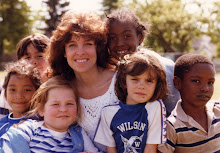Fifteen years ago I heard a research report that measured creativity in young kids and then again at a later age. The results were alarming. A huge percentage of kids were judged creative at age 5, and then the number dropped precipitously after several years in school. I have kicked myself ever since for not noting the citation.
And then recently, out of the blue, children's author Derek Munson shared the same stats during a presentation. I talked to him afterward and got enough of the details to track down the description of the research. Suffice it to say, Derek is one of the most creative people I've met. His "alien baseball players" Web site launches this week, if his work on friendship and creativity doesn't hook you.
Here's the research description:
Accessed on 5/21/09 fromAnd then recently, out of the blue, children's author Derek Munson shared the same stats during a presentation. I talked to him afterward and got enough of the details to track down the description of the research. Suffice it to say, Derek is one of the most creative people I've met. His "alien baseball players" Web site launches this week, if his work on friendship and creativity doesn't hook you.
Here's the research description:
Are We More or Less Creative as We Age?
In Creativity and Innovation
A 1968 study by George Land, a general systems scientist interested in the development of creative performance, revealed that we are naturally creative as children. However, as he shared in Grow or Die: the Unifying Principle of Transformation, as we grow up we learn to be increasingly uncreative.
How did George Land prove this?
Over a 15 year period he distributed among 1,600 5-year-olds a test designed to measure creativity. This test was used by NASA to select innovative engineers and scientists. George Land used the test to re-test the same children at 10 years of age, and again at 15 years of age. Here are his results with regards to their creativity:
5 year olds: 98%
10 year olds: 30%
15 year olds: 12%
The same test was also given to 280,000 adults with a 2% score for their creativity.
Why are adults not as creative as children?
For most, creativity has been buried by the structures we build that involve rules and regulations. Our educational system was designed during the Industrial Revolution over 200 years ago, to train us to be good workers and follow instructions.
Creativity is a skill that can be developed. Learning to be creative, like most things in life, requires practice to develop the right muscles, and a supportive environment in which to flourish.
How did George Land prove this?
Over a 15 year period he distributed among 1,600 5-year-olds a test designed to measure creativity. This test was used by NASA to select innovative engineers and scientists. George Land used the test to re-test the same children at 10 years of age, and again at 15 years of age. Here are his results with regards to their creativity:
5 year olds: 98%
10 year olds: 30%
15 year olds: 12%
The same test was also given to 280,000 adults with a 2% score for their creativity.
Why are adults not as creative as children?
For most, creativity has been buried by the structures we build that involve rules and regulations. Our educational system was designed during the Industrial Revolution over 200 years ago, to train us to be good workers and follow instructions.
Creativity is a skill that can be developed. Learning to be creative, like most things in life, requires practice to develop the right muscles, and a supportive environment in which to flourish.
http://blog.entrepreneurthearts.com/2009/03/04/are-we-more-or-less-creative-as-we-age/




Hey, nice site you have here! Keep up the excellent work!
ReplyDeleteWeb Site Designer San Francisco